Birds are amongst the most easily seen of wild animals, they are probably also the most easily identifiable. Superficially similar, they vary greatly in what they eat, where they go and how they live their lives. Some brave the weather all year round in the same region, others fly thousands of miles to follow the sun, and/or abundant food supplies.
Aves - Birds - Animalia
There are about 10,000 species of birds. They are found worldwide from the deep Arctic to the deep Antarctic and all stations in between. The fact they can fly in and fly out again means that they are able to make short visits to many places to take advantage of seasonal food supplies in a way that other animals can't. They are able to make use of what otherwise would be very harsh environments by visiting in the better months only.
Birds are the most recently evolved of the vertebrate classes, with the oldest fossils going back about 160 million years. They are considered to be the modern descendants of the dinosaurs, being the only direct evolutionary line that survived the extinction event that wiped out all the other dinosaurs about 65 million years ago.
Typical Birds

House sparrow (female), Passer
domesticus - Passeriformes
A contender
for the commonest wild bird title. Originating in Europe
house sparrows are found across 2/3rds of the worlds
land surface.
picture used
permission of David Friel
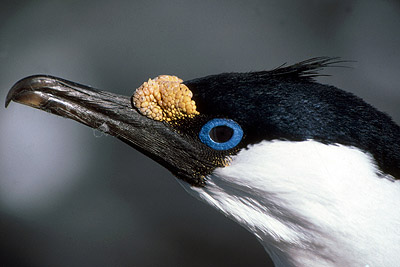
Blue-eyed shag, Phalocrocorax
atriceps - Pelecaniformes
The blue
ring surrounds the eye, it is not the iris,
the yellow wattle develops during the breeding season
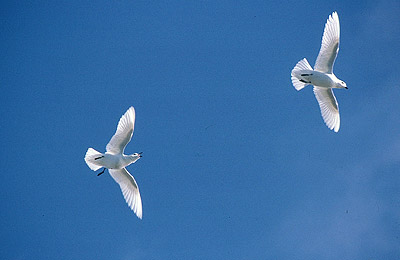
Snow petrels, Pagadroma nivea,
Procellariiformes
Courtship behaviour, the female
out in front leads the male who must prove himself by
following her aerobatics that often take place close
up to cliff faces. In a relatively calm moment, the
male is calling to her.
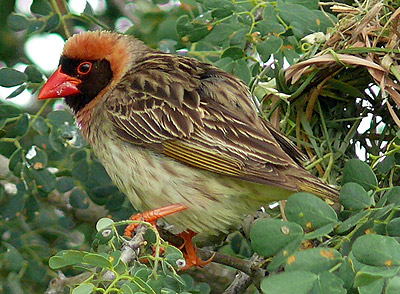
Red-billed quelea, Quelea
quelea - Passeriformes
Another contender
for the commonest wild bird title. Found in sub-Saharan
Africa, there are estimated to be 1.5 billion of these
small birds, though other figures have put the number
at up to 10 billion. They are regarded as being a significant
pest as huge flocks can settle on and decimate crops
grown for human food.
picture
- Bernard DUPONT from FRANCE, CC2 Attribution-Share
Alike Generic license.
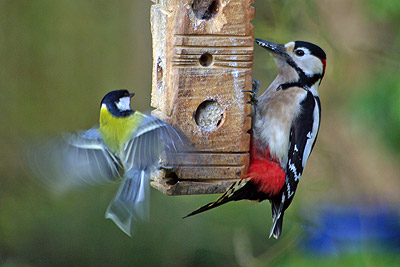
Great tit, Parus major
- Passerine (left) and Greater Spotted Woodpecker,
Dendrocopos major - Piciforme (right)
on a garden bird feeder.
Almost anywhere in the world,
it is possible to put out a feeder in your garden and
start to attract the local bird life so you can see
it (fairly) close up. I use porridge oats mixed with
dripping to stuff the holes in this piece of wood in
my garden that hangs from a tree.
Cool Birds
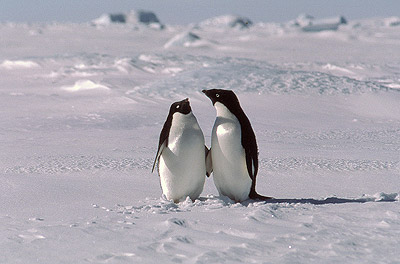
Adelie penguins, Pygoscelis
adeliae - Strigiformes
these are probably
two males rather than being a breeding pair. Penguins
usually mate for life, these are on the sea-ice in Antarctica
early in the spring, the males arrive first and make
a nest for the later arrival of the female. They often
travel together whether on ice or sea.
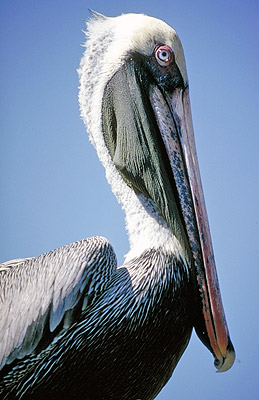
Brown Pelican, Pelicanus
occidentalis urinator - Pelecaniformes.
A typical pelican, this one is from the Galapagos.
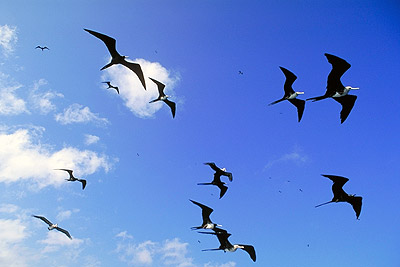
Magnificent Frigate Birds*,
Fregata magnificens - Pelecaniformes
This group are heading out to sea to go fishing in the
Galapagos Islands. The ones with white under-bellies
are female, while the darker ones are male. These are
large birds with up to a 2.3m wingspan. *This is their
full name, we missed a trick there, we could have been
the "Magnificent Humans" if someone was paying attention.
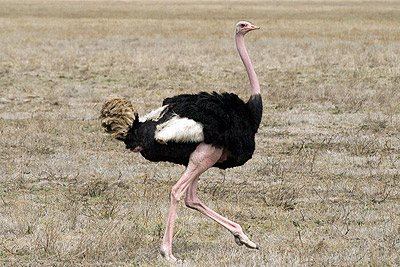
Ostrich, Struthio camelus
- Struthioniformes
Native to Africa where it is widespread,
the ostrich is the largest bird, lays the largest egg
and runs faster than any bird at up to 70 kmh (43 mph)
picture - Stig Nygaard from
Copenhagen, Denmark, CC2 Attribution Generic license.
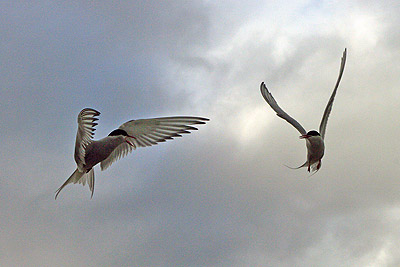
Arctic terns, Sterna paradisaea
- Charadriiformes
Despite just weighing about 100g
(4 oz), these birds fly around 90,000 km (56,000 mls)a
year from the Arctic to Antarctic and back again. During
this they experience both polar summers and see more
daylight than any other animal on earth.
Kingdom - Animalia
Phylum - Chordata
Subphylum - Vertebrata
Class
- Aves
Basic Features:
Aves is a Class in the Subphylum Vertebrata of the Phylum Chordata, so they have all of the characteristics of both of these groups in addition to the following:
- Waterproof skin covered in feathers
- Endothermic, warm blooded
- Hard shelled eggs that are waterproof (cleidoic - closed egg)
- Beak or bill rather than teeth
- Bipedal (walk on two legs only)
- Forelimbs developed into wings
- Most members are highly adapted for flight with forelimbs modified as wings and many weight saving features such as hollow bones
What do birds eat?
You would expect such a widespread and varied group as the birds to include members that eat most things. This is largely true, though there is usually one common factor to the food eaten by birds and that is that it is high-energy.
Birds have the highest body temperatures of any animal with the highest metabolic rate in terms of energy needed per gram of body mass.
This means that they can't afford to waste time eating bulky low energy foods as they wouldn't be able to be so active. It also means that they need highly concentrated energy foods in order to still be light enough to fly. Birds can't keep food in their digestive systems for long as the weight would soon build up and make flight very difficult. There are no bird equivalents of cows or sheep for instance.
As examples of the energy needed, a warbler (small songbird) might eat 80% of its own body weight a day, while a shrike can digest a whole mouse in three hours.
Generally speaking food from an animal source, invertebrates, fish, small mammals, other birds etc. is more nutritious than much plant derived food.
Birds that do eat plant material eat the higher energy parts such as seeds, nectar and fruit rather than leaves and stems. Those birds that do eat leaves tend to be very selective choosing only the most tender nutrient dense ones that are the easiest and quickest to digest.
One herbivorous bird, the Canada Goose removes the easy to get at nutrients from grass that it eats and then rather than further digestion to recover more nutrients, it defecates it out and then eats fresh grass. The faecal pellets so produced may be eaten by reindeer such is their remaining nutritional content.
Another unique aspect of the way that birds feed is that they have a beak or bill and no teeth, most food is swallowed more or less whole and not chewed in the way that other animals might. The digestive systems of birds are very efficient with a gizzard to grind up the food and very aggressive digestive enzymes.
Birds eat fish, squid, worms, grubs, ant and termite eggs, other birds, small mammals, snakes, lizards, frogs, toads etc. any animal smaller than them that they can catch.
They may eat fruit, seeds, unopened flowers, young leaves, buds, nuts, and other concentrated energy easy to digest plant material.
What eats birds?
Catching birds to eat is not easy because they can quickly fly away. However while flight enables them to escape predation it also puts them in the way of predation.
Flight requires birds to be lightweight, so when they reproduce, they carry the young for as short a time as possible. The fertilized egg with a very large food supply is produced. This means that birds are tied to their nests in order to reproduce which makes them very vulnerable to predation at this time. So what eats birds?
- Predatory birds such as falcons, eagles, hawks and owls eat other birds.
- Domestic cats eat birds, catching hundreds of millions a year world-wide, perhaps billions.
- Some unexpected animals like large spiders, frogs and toads eat small birds.
- Mammalian predators such as stoats, weasels, raccoons, jaguars, foxes, lions, tigers, and bears will eat birds especially if they can catch them on the nest where even if they don't catch the adults, there are likely to be nestlings or eggs to eat.
- Seals, sharks and large fish eat water-birds.
Birds are often in the middle to the top of food chains being both predator and prey to different animals.
The group includes:
Possibly more than any other animal group, the birds are the easiest to identify and the least likely to be mis-identified. The combination of the obvious characteristics of bipedalism, a beak and feathers is unmistakable. There are around 10,000 species of birds arranged in 29 orders, some examples are given here:
- Anseriformes - waterfowl, web-footed for swimming - ducks, geese, swans
- Apodiformes - "footless" in Latin (they do have feet though), legs are used for perching and have no scales as other birds do - swifts, hummingbirds
- Cathartiformes - large scavenging birds, usually have a bald, featherless head - New World vultures or condors
- Charadriiformes - usually found around water, frequently the sea - gulls, auks, plovers, terns
- Columbiformes - the only birds capable of drinking by sucking without having to tilt the head back, able to produce "crop milk" to feed the young - doves and pigeons
- Falconiformes - raptors, sharp hooked beak, strong legs and feet with strong claws - falcons, eagles, hawks
- Galliformes - fowl, ground feeding, heavy bodied birds, usually able to fly but only for short distances, walk to get about - chicken, turkey, grouse, pheasant, ptarmigan
- Opisthocomiformes - young possess claws on two of their wing digits (fingers), a very primitive feature - a single species the hoatzin
- Passeriformes - songbirds or perching birds, usually smallish birds, more than half of all bird species are in this order - sparrows, crows, drongos, birds of paradise, larks, swallows
- Pelecaniformes - water birds that feed on marine life, webbed feet, some have a large throat pouch - pelicans, cormorants, frigate birds
- Phoenicropteriformes - long-legged, long-necked filter-feeding waders - flamingos
- Piciformes - mainly tree-dwelling, feet have two toes forwards, two backwards - woodpeckers, toucans,
- Procellariiformes - tubenoses, most feed in the open sea, nostrils in tubes, nasal gland to secrete excess salt, long narrow wings, webbed feet - albatrosses, petrels
- Psittaciformes - mostly tropical and subtropical, strong curved bill, upright stance, strong clawed feet, often bright or vivid colours - parrots, macaws, cockatoos, parakeets
- Sphenisciformes - aquatic flightless birds found in the southern hemisphere only as far the equator - penguins
- Strigiformes - sharp hooked beak, strong legs and feet with strong claws, large forward-facing eyes in a characteristic and obvious circle of feathers, binocular vision, the eyes can't move in the socket so the whole head moves - owls
- Struthioniformes - ratites, large flightless birds, no "keel" on the breastbone (sternum) which is used in other birds attach their flight muscles - ostriches, emus, kiwis
The smallest bird is the bee hummingbird at 5.7cm (2.25in) long and 1.6g (1/18th of an ounce).
The largest bird is the ostrich at over 2.7m (9 feet) high, weighing 156kg (345lb), this is 97,500 times heavier than the smallest bird.
The largest wingspan is that of the wandering albatross with a measured maximum of 3.63m (nearly 12 feet).
The commonest bird is the domestic chicken as it is reared for food, there are around 4 chickens for every person on earth which comes to 25 billion + chickens. Of wild birds, the European house sparrow is thought to be the most common being found on about 2/3 rds of the land surface. A small songbird, the red-billed quelea is thought to be close in numbers with a population of 1.5 billion though is confined to sub-Saharan Africa.
Banner picture at top of page - Barn owl, Tyto alba, courtesy of Carlos Delgado, under Creative Commons Attribution, Share Alike 4.0 International licence.
